The Huawei P8 Review
by Andrei Frumusanu on June 4, 2015 8:00 AM EST- Posted in
- Smartphones
- Huawei
- Mobile
- P8
- Kirin 930
Display Measurement
Continuing on to the display, we find a JDI manufacured 5.2" IPS-Neo screen together with a NovaTek NT35695 display controller IC that also saw use in various devices among also the HTC One M8. IPS-Neo promises increased contrast ratio over traditional IPS displays, and we've already confirmed this claim in the Huawei Mate 7 which also used a similar type of display.
As always, our display testing is done with an X-Rite i1Pro 2 spectrophotometer as our measurement hardware, in conjunction with SpectraCal's CalMAN software suite and our own workflow to be able to get an accurate display characterization.
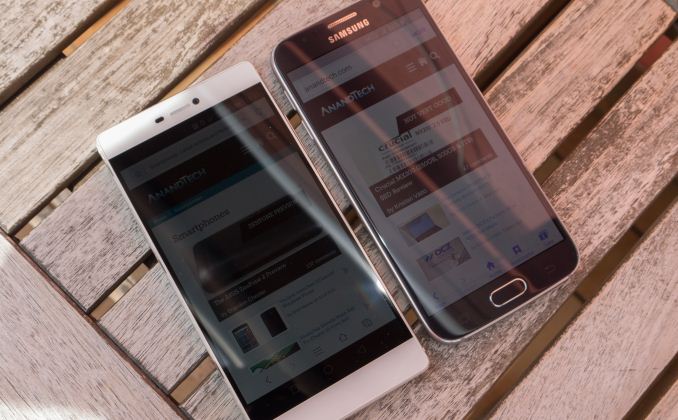
Huawei P8 and Samsung Galaxy S6 in direct sunlight
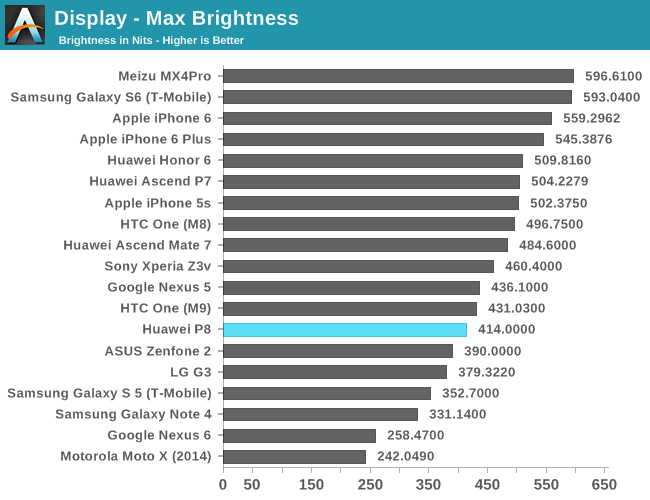
We start off with the maximum brightness of the display: The P8 seems to exhibit itself as one of the more dim LCD devices as it doesn't exceed the 414 cd/cm² mark. Readability on a bright day isn't too fantastic, but still very usable as long as the sun doesn't directly shine on the display.
I noticed a very weird behaviour of the display's brightness that cannot be explained by usual mechanisms such as CABC. The OS clearly alters brightness depending on the application - for example using a browser such as the stock one or Chrome, along with other random applications such as Dropbox or FX Explorer will cause a dimming in the display, if one opens up the recents menu or goes back to the home-screen then one can see how the backlight brightens up. One would think this can be explained with by assuming the default launcher and OS elements are allowed a higher luminosity than other apps, but I've discovered that many other apps don't dim the display.
Huawei's luminance steps are also far from even - there is a noticeable sudden jump from around 200 nits to 350 nits without any inbetween levels. While this poses no real practical issue, it's odd to not see smooth brightness adjustments on a modern flagship such as the P8.
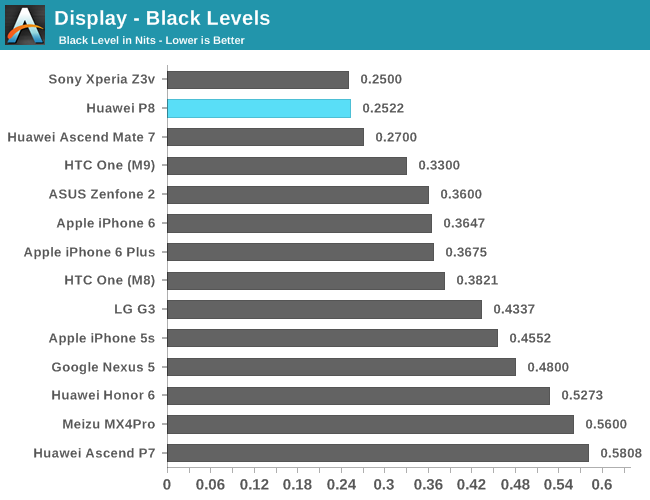
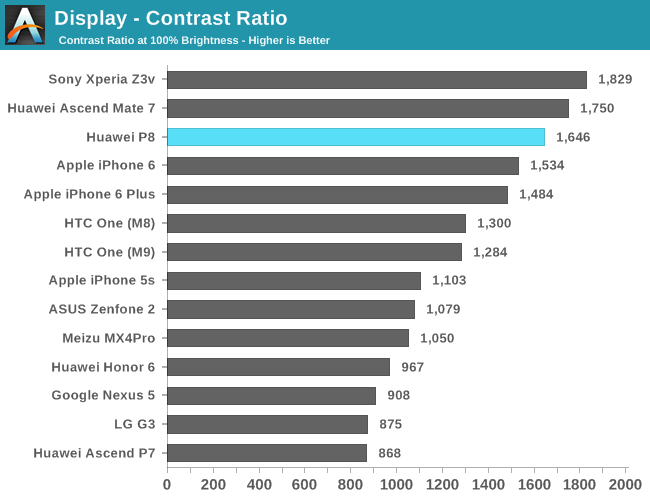
When looking at the black levels, we see the clear advantage of the IPS-Neo technology as the two devices sporting the panels are ahead of other LCD alternatives. As a remark on the graphs: The Sony Z3v makes use of CABC to achieve its high dynamic contrast ratio, as such it doesn't represent the true contrast of the display panel. As the P8 and Mate7 do not employ any APL-dependent brightness controls, they show the panel's true strength.
At maximum brightness, the P8 reaches a contrast ratio of 1646:1, a tad over the 1500:1 that Huawei advertises in its marketing materials. It's on medium brightness though that the display shines, as we see a contrast ratio going up to 2827:1 at 200 cd/cm², as blacks get darker the further away one is from the maximum panel brightness.
The P8 dissapointingly offers no super-low minimum brightness for late-night usage, as it bottoms out at around 10.5 nits, higher than the ~2 nits we've seen vendors like Samsung or Meizu achieve.
The unit we've received from the London launch event suffered from a very bad case of backlight bleeding. This was especially visible in the bottom left corner of the device where one would notice the uneven luminosity even in normal applications, and this was exacerbated by the fact that the navigation bar has a black background. I suspect this is a build-quality issue, as, funnily enough, squeezing on the frame and edges around the display will actually diminish the backlight-bleed for some time until slowly it reverts back to a state similar as captured in the above photograph.
Before we continue on with display accuracy measurements, I want to take a moment to explain Huawei's temperature control mechanism integrated in the OS's system settings. Huawei has long had this feature implemented in previous devices, and we covered it in the Mate 7 review. Choosing the warmest temperature on that device resulted in a mess of a display with a green-dominated white at 6073K, making that setting utterly unusable. The P8 differs strongly from these older devices by offering an excellent calibration when setting the colour temperature slider to the warmest possible value. As this slider offers no discrete setting other than the minimum, default and maximum values, it was previously unreasonable to try to hit a reproducible "accurate" setting. With the P8 now offering this accurate "mode" straight out of the box on the minimum setting, we see it as an equivalent to the "Movie"/"Basic" display modes on Samsung devices, and will thus use it as the de-facto measurement point for display accuracy in this review. For comparison's sake, we also show the "default" setting with which the devices comes set up.
Warmest Colour Temperature
Default Temperature
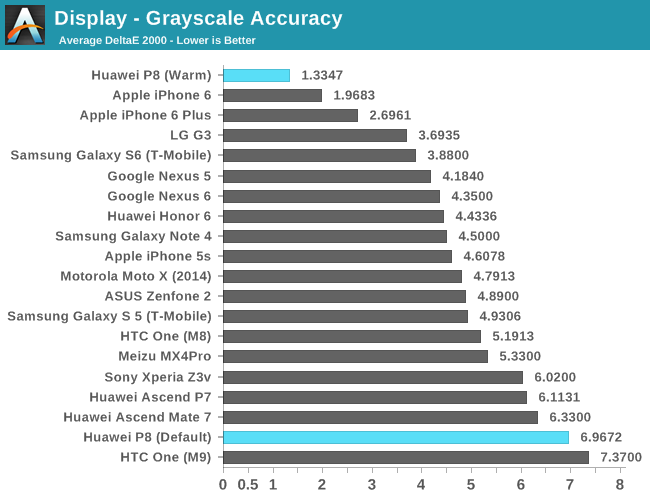
Having cleared up the colour temperature settings and explained how Huawei chooses to expose it to the user, we can see some outstanding results in our grayscale accuracy measurement. The P8 manages to achieve an outstanding deltaE2000 of 1.3347, putting it far ahead of many devices, including Apple's iPhones. Staying on the default colour temperature on the other hand makes the grayscale accuracy degrade from the best to one of the worst devices in our benchmarking database, reaching a deltaE2000 of 6.96.
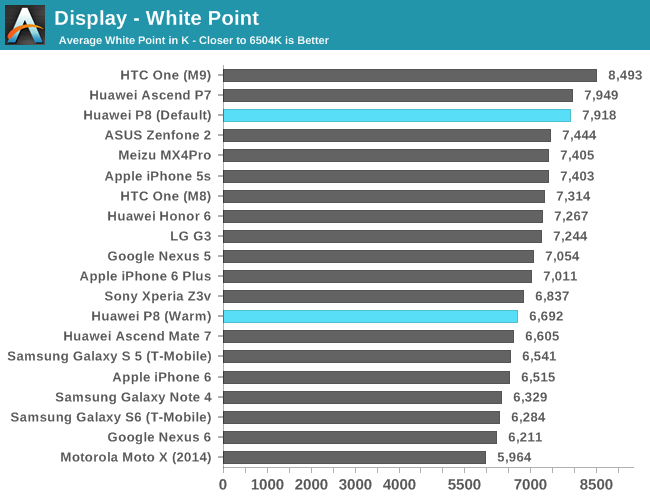

While the altered colour temperature settings helps the P8 achieve a better saturation accuracy metric of deltaE2000 of 2.180 instead of 4.8764, it doesn't match up to the performance we saw in the grayscale accuracy test. The P8's gamut remains too large and veers off from the sRGB targets in the blue and green spectrums.
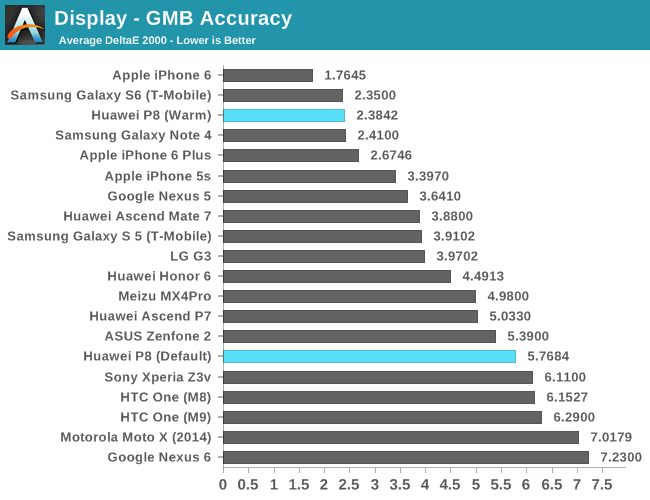
In the GretagMacBeth test we see the P8 perform very well with a dE2000 of 2.3842 (And naturally, a much worse dE2000 of 5.76 on the default settings).
Overall, the verdict on the P8's screen is a bag of mixed feelings. If I hadn't tested the colour temperature slider this would have easily been a very straightforward conclusion to write. The average brightness range of the display together with the problematic uneven backlight and bad viewing angles would have been enough to deem this as one of the worst displays of this year when tested under the default settings. Fortunately for Huawei they pulled an unexpected rabbit out of a hat and delivered some quite excellent numbers on colour accuracy.
I'm not sure if Huawei implemented this on purpose, or it's a one-off coincidence, but I hope the company continues to offer a calibrated baseline which is easily selectable, through the colour temperature slider or other means such as display profiles. In the end, it's up to the end-consumer to decide what aspect is more important to them as we weigh out the pros and cons of the display.
Display Power
Measuring the device's luminance-power curve is can be a very useful tool to analyze and estimate the power efficiency of not only the screen, but also the internal components of the device. Althrough I didn't dare to completely dismantle the P8 to get hard readouts through an external power supply, I did manage to fiddle around with the internal fuel-gauge to be able to get some clean numbers that hopefully get near the real thing.
First off, we can see that the P8 is able to reach quite good results at minimum brightness, going down to about 508mW at 10.6 cd/cm². We saw similar data-points from the Meizu MX4Pro which reached down to 530mW at minimum brightness, and the Note 4 which can go down to 440mW on a black screen. The P8 performs well here and points out to good idle power-management and to the inclusion of Panel-Self-Refresh (PSR) through the NovaTek display controller IC.
The maximum power can reach up to 1373mW, and if we substract the idle power from that figure we reach a luminance power load of about 870mW for 433nits, which is in the ballpark of other LCD devices, but for example loses out in efficiency by 100mW at the same brightness when compared to the slightly larger screen of the MX4Pro. Looking at the 200nits point then again fares better for the P8 as it wins with around 340mW versus 356mW for the Meizu, pointing out to different scaling in luminance-power between the two screen technologies.


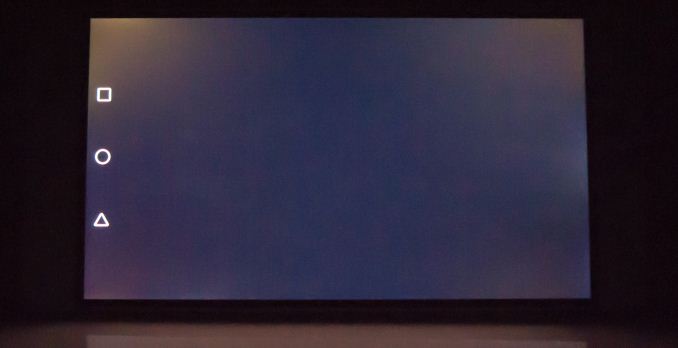

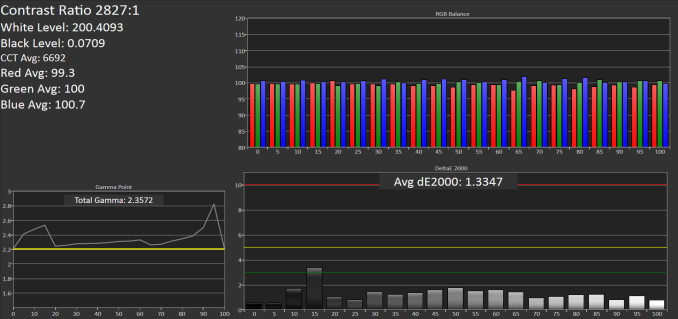

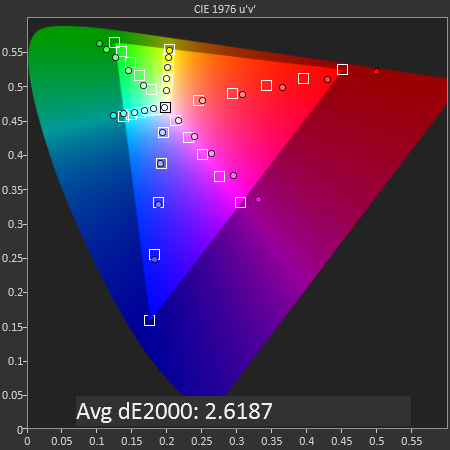


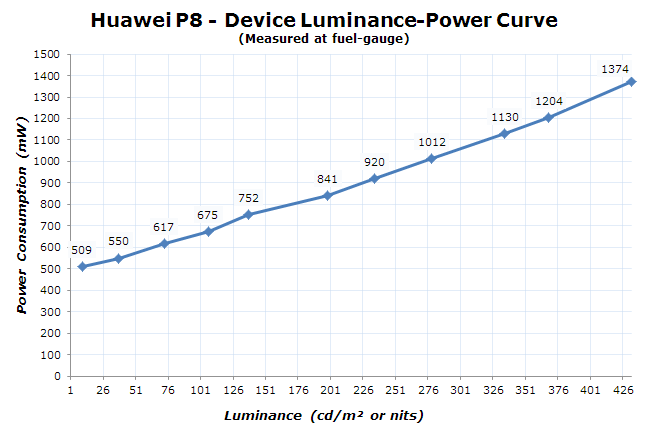








104 Comments
View All Comments
Peichen - Friday, June 5, 2015 - link
I am an iPhone 6+ user but I have no problem this review uses Galaxy S6 camera for comparison as the S6 have an excellent camera. The SONY RGBW sensor in this camera might be used in the upcoming iPhone 6S in September and it will be interesting to see with SONY and Apple's refinement how it will stack up against Note 5 and G4.serendip - Friday, June 5, 2015 - link
Huawei should really stop with this Kirin nonsense. The modem sucks power, the SOC's power management is a joke, yet Huawei are crazy enough to charge flagship prices for a midrange phone that struggles to keep up with much cheaper offerings. A Mi Note is a cheaper and better option.TekDemon - Saturday, June 6, 2015 - link
I know this isn't a nexus review but these charts would look rather different if a nexus 5 running 5.1 and a nexus 6 on 5.1 were used since Lollipop 5.1 finally brought a lot of changes into android that were manufacturer dependent. The nexus 5 on 5.1 posts better random writes than any of the phones on this list for example.OOwl - Saturday, June 6, 2015 - link
I do agree with you in terms of 5.1 improvements. I am currently testing a small upcoming Motorola handset and although it's not a monster in terms of power and should be on paper lower powered than the processor in the P8 Lite, it is soo much more responsive. Battery life is also rather underwhelming on these Kirin SoC powered handsets...R3MF - Saturday, June 6, 2015 - link
just picked this up on contract for £21x12, or looked at another way; ~£250 for a phone with 300m/5000t/1gb.for that price its flaws pale into insignificance.
sunnohh - Sunday, June 7, 2015 - link
Jelly, 1 year contracts across the pond! Extremely low rates. Don't tell me you get reliable service everywhere.R3MF - Sunday, June 7, 2015 - link
i live in a rural area, we never get reliable service. :)sunnohh - Sunday, June 7, 2015 - link
I pay 45$ for unlimited call text and 5gig data through wal mart's plan that uses an AT&T sim. Nexus 5 is about 97% reliable, but it's bring your own phone. Which around here is the exception rather than the rule. The rule being Verizon near 100% reliability and exhorbinate rates and long contracts with obscene break up fees.Ethos Evoss - Friday, June 12, 2015 - link
Jeeezus anandatech u made me sweat PROPERLY I finished this mega ,tera hexa .. eem .. NO !I will go rather other way ...
It took me over and hour to finish this mini, micro , nano , piko , errr.. I'll skip rather all metrics and I'll jump directly to deep ATOM review I have EVER seen in my life ..
ALWAYS when it comes to Huawei devices especially to find EVERY single NEGATIVYTY to their products..
I will say you are MOST weirdest website in actual WORLD ..
But that's fine that is your probably style to do autopsy to find weakness..
To summarize your (in few ways) misleading review to pull people off buying phone bcos of bribed by apple or who knows who doesn't bother me .. but u are cowards anyway ..
we can start :
1.introduction and design:
* ''only supports UE Category 4 LTE speeds, reaching up to 150Mbps downstream and 50Mpbs upstream.''
-So u claiming that this phone supports LTECat 4 only ?? u liying or u have wrong info as this phone supports LTECat 6 !
*''We had some very harsh words for Mate 7’s camera performances, as both featured very disappointing photo and video quality.''
-Ecxuse me ?? I have feeling that u HAS no experience of taking pictures at all I own Mate 7 and everybody says that my pictures on phone are amazing WTF u trying to say weirdos?? liars! isheep!
*''This is the second kind of implementation RGBW (Or RGBC) after the OmniVision unit found in the original Moto X.''
-yeah why u higlighting it IT WAAS second?? why nobody been talking about it THEN in crappy fail moto x ? what u trying to protect ? or put itno negativneses ?? so WHAT if it''s second ?seriously!
*''It should be noted that the black frame surrounding the actual screen makes it seem as if the device’s size-bezels are much smaller than what they really are, something which is very visible on the lighter coloured models.''
-yeah u picked white version so what u been expecting ?? so stupid every phone which is in withe color must have black borders jesus christ u are unbelieveable .. did u mention this in crapple iphone 6 review? you need more knowledge that if u have black screen version u don't notice any borders! mentals..
*''Huawei called the design a “single audio chamber speaker system”, but in practice the right grill is essentially just for aesthetics and only serves as a housing for the bottom microphone. Covering up the left grill will completely dampen the audio output of the device.''
-eem excuse me and what is the problem that phone has simetrical grills which gives better look ?!?
on your crapple phone wht is there 5 holes on right side and 2 on the left how rubbish crap looking !
dampen audio ?? oh yeah even iphone 5 or 6 or s6 or edge has dampen audio bcos everybody covers holes so obviously sound will be dampen WTF u mentiong this SHT??1?!!? ar u nuts?
* camera module seems to be still 1.5mm underneath the glass.
-ar u serious with this mention ?? jeezus christ .. u are total weirdos FOR REAL ! ATOM REVIEW!
*''he only gripe I’ve had with it is that it seems to have some empty space underneath the back of the phone as if you try to squeeze it will flex inwards by up to 1mm''
- Whaaaaa??? OMG what THE HELL are you doing with smartphones seriously u need HELP !
2.Software - EmotionUI 3.1
*''Huawei continues the choice of not including an application drawer with the EmUI launcher, so all installed apps are placed on the launcher screens.''
-So what? BETTER NOT complain here as u wud have to complain to your beloved iphone so u rather stayed quiet right ?
*''It would be appreciated if Huawei had at least included the option to disable app-icon framing throughout the OS''
-I NEVER EVER heard in my life that SOMEBODY wud comes up with this NON-SENSE sht called ''app-icon framing throughout '' trully u are word inventors ! ... app icon framing .. jeezus christ ..
*''I've praised Huawei's inclusion of a per-app permission manager in the Honor 6 and Mate 7, and it sadly seems that the P8 drops this practice as it no longer is exposed to the user''
-the reason why they didn't include this feature anymore was because all constant annoying remind to close all important apps and services which needs to be running and users been complaining by not receiving notifications , locations not found ! in other phones never been why it bothers you now???
*Although the P8 lacks a fingerprint sensor ''
-trully who uses it?? nobody .. only gay geeks with their glasses 200 bioptries
*''a feature where one would double-tap or draw with a knuckle to capture a screenshot''
-I believe if u root the phone which is easy to do so .. u can nicely disable this feature in file systems (eg build prop)
3.CPU & System Performance
I really NOT going to break down this section as there are 1000 negativeness I would be here till next christmas..
Simply your bars, graphs and compares ARE TOTAL POINTLESS/USELESS t
Completely obsolete as I browse or edit on my mate 7 or on P7 perfectly no problems as any other phone.
I noticed that If iphone or any other phone you adore has less or shame/laughable results u simply not include it in your graphs .. u cowards ..!
4.GPU Performance
Same as above no comment on useless completely not REAL world results as everybody plays games on the phone without any issues .. or play films.. on P7 we normally watch youtube vids in 1080p or 720p without problem ..
yeah your pathetic iphone can be on top but good luck it its even crappier battery which will stay last half a day or less !
5.WiFi Performance and nand
I really don't understand another pointless tests of wifi performance ..
it is clearly USELESS /POINTLESS to have strong wifi another battery drain ??
Wake up, u measuring NETWORK speed instead of INTERNET speed ! What u wanna tell me now u playing multiplayer over smartphones behind desks like idiots like onPC where wifi network speed is inevitable
Pleease DON'T be naive, Huawei instead of you THINK and don't implment stupidly highest wifi module tuner radio JUST for pointless network speed which nobody will NEVER use it for every day use ! Everybody needs fast internet download speed for quick loading pages or downloading files don't you think ? And this P8 managing at best ! Yu fkin thanks god u didn't unsolder wifi chip to check if it's OK or what.. myyy gooosh ..
* While the new eMMC doesn't break any records, it's now among the "average" performing devices out there, as opposed to the horrendous performances of the Mate 7 and Honor 6
-horrendous .. wow so dramatic? I never noticed any horrendous like u oddly describing - bitching !
6.Display Measurement and power
*''together with a NovaTek NT35695 display controller IC''
-jez so u mentioning controller wt-hell and u can tell us brands of capacitors and resistors too ? i think that is important too n ?
*''I noticed a very weird behaviour of the display's brightness that cannot be explained by usual mechanisms such as CABC. The OS clearly alters brightness depending on the application - for example using a browser such as the stock one or Chrome, along with other random applications such as Dropbox or FX Explorer will cause a dimming in the display, if one opens up the recents menu or goes back to the home-screen then one can see how the backlight brightens up. One would think this can be explained with by assuming the default launcher and OS elements are allowed a higher luminosity than other apps, but I've discovered that many other apps don't dim the display.''
- Right here is ONLY first thing right now I can agree with this issue ... yes I have noticed dimming in chrome but u didn't consider it is caused by app ? the chrome app causing this and some others because when u open chrome it auto changes resolution don't thik that you surfing in 1080p ...
this happens to me with my mate 7 so i just increase brightnes a bit and volia .. problem solved..
*''Huawei P8 backlight bleed''
Every phone with ips screen has bleed it is caused by stress which is put by phone frame where screen glass lies .. i means that you will NEVER craft housing middle frame bezel 100% straight by machine .. it would have to be laser machine NOT CnC .. so when screen is placed into frame there is significant bend , squeeze of glass ass glass is slightly bendable elastic
Huawei's GREAT feature which NO ONE phone has it is white Color temperature
In this case , I will call it ; this new case (new and new IPS technologies comes across) this neo-ips screen it seems that is not playing together with color temperature feature..
As it perfectly works with M7(mate7) P7 I have color temperature set nearly to max about 85% !
Looks like due to new IPS technology and that RGBW or RGBC feature in LCD has conflict !
In this case (as been this explained in warm results and cold results) It is necessary that once user will be watching films or photos will have to change color temp to warm and WHEN will be surfing on internet and reading text definately slide it to the cooler side ... (not max as it result bluish distortion)
7.Battery life and charging
Again your beloved iphone has to be on top.. aaahh well ...
I truly doubt it is better than mate 7 .. rubbish .. ppl saying it has not great battery at all ..
I won't comment this
In my real world battery life on my mate 7 is nearly two days and on my GF's P7 is whole day ..
I don't genuinely believe your iphone or others has better battery .. NO chance !
For charge I don't mind as I charge phone over night so in morning all is ready ...
8./9.Camera and video
Only to say that seen couple vids on youtub or pics on parena or Garena and ppl managed to make nice, great photos so don't really understand your AGAIN so much hatress to this phone
I agree video recording is not good part but pictures are very good and even at night ..
10.
DISASTER ... ANANDATECH ....YOU are ICON of the internet
I will name you KINGS of WEIRDO-GEEKS ... :DDDDD
Huawei haters from unknown reason ... bribed by apple ? to keep your site above water..? as everybody corrupted smartphone sites..
Remember Huawei phones ARE NOT for any performance .. you are brainwashed by your fixed bug in head that all in the world HAS to be highest, fastest, best... you are all wrong..
Huawei manuf. they DID described it what they phones are for.. for what use
Firstly for elegance , then smart look, for smart ppl not for kids like you type; aah that is sloow that is crap I don't want it gpu and cpuu is sloow..
This smartphone is for grown ppl grown man in suits , for managers, for social women in beautiful dress they love nice and sleek and slim light design, which they will stick this review into your ass and we will say ''WE SIMPLY DO NOT CARE'' if it's not highest specs. GTFOOO
|You GLASS-GEEKS
CIAO
hmdqyg - Wednesday, June 17, 2015 - link
The "T-Rex Offscreen Power Efficiency" is pretty useful. Could you perform the same test on Tegra X1, Tegra K1, A8x, Snapdragon 810 and Snapdragon 801?